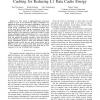315 search results - page 2 / 63 » On reducing load store latencies of cache accesses |
MICRO
1995
IEEE
13 years 8 months ago
1995
IEEE
Untolerated load instruction latencies often have a significant impact on overall program performance. As one means of mitigating this effect, we present an aggressive hardware-b...
ICS
1998
Tsinghua U.
13 years 9 months ago
1998
Tsinghua U.
In order to achieve high performance, contemporary microprocessors must effectively process the four major instruction types: ALU, branch, load, and store instructions. This paper...
FPL
2007
Springer
13 years 11 months ago
2007
Springer
Recently, a dedicated hardware accelerator was proposed that works in conjunction with caches found next to modern-day microprocessors, to speedup the commonly utilized memcpy ope...
MICRO
2005
IEEE
13 years 10 months ago
2005
IEEE
Conventional processors use a fully-associative store queue (SQ) to implement store-load forwarding. Associative search latency does not scale well to capacities and bandwidths re...
ICCD
2006
IEEE
14 years 1 months ago
2006
IEEE
— L1 data caches in high-performance processors continue to grow in set associativity. Higher associativity can significantly increase the cache energy consumption. Cache access...

